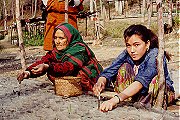

Bhutan 
 |
Wood Energy Situation Policies and Programmes Wood Energy Data Further Reading RWEDP Focal Points |
Wood Energy Situation
Bhutan presents a unique scenario for energy production and consumption. From being a net importer of all (over 91%) conventional energy consumed in the country in 1979, it has become a bulk exporter of hydroelectricity. However, the consumption woodfuels has continued to increase and its share in total energy consumption in 1994 was still as high as 86%. The household sector is the single biggest consumer of energy, accounting for about 76%. About 98% of its requirement is met by biomass - mainly fuelwood. Users in other non-domestic sectors together consume about 23% of total energy consumption. About 50% of the energy consumed in these sectors is in the form of fuelwood and charcoal and other biomass use is only minimal.
Except in urban centres and towns, most fuelwood used by both domestic and non-domestic sectors is collected by the users themselves. Even the larger users of fuelwood, i.e. agro-processors, government institutions, commercial establishments, road constructors, monasteries, etc. rely on self-collected fuels from government forests.
Policies and Programmes
 In spite of the importance of fuelwood in meeting national energy demand, the energy sector has yet to give it adequate consideration for its inclusion in sectoral plans and programmes. The country has as of yet no comprehensive national energy policy and, under the old Forest Act of 1969 (which is now under revision), no popular stake in protecting and managing forests. Further, the diverse physiographic variations, un-balanced distribution of the population and natural resource base, the growing demand for new land for agricultural expansion, and the need for the preservation of environmentally sensitive areas, etc. all act as constraints to meeting the gap in woodfuel supply and demand in areas without natural forest. They also pose a severe threat to the sustainable management of the existing resource base. Limited access to alternative energy sources will also force the country to rely on fuelwood for some time to come.
In spite of the importance of fuelwood in meeting national energy demand, the energy sector has yet to give it adequate consideration for its inclusion in sectoral plans and programmes. The country has as of yet no comprehensive national energy policy and, under the old Forest Act of 1969 (which is now under revision), no popular stake in protecting and managing forests. Further, the diverse physiographic variations, un-balanced distribution of the population and natural resource base, the growing demand for new land for agricultural expansion, and the need for the preservation of environmentally sensitive areas, etc. all act as constraints to meeting the gap in woodfuel supply and demand in areas without natural forest. They also pose a severe threat to the sustainable management of the existing resource base. Limited access to alternative energy sources will also force the country to rely on fuelwood for some time to come.
Wood Energy Data
| General | |||||
| Population (1996) | 1.8 mln. | ||||
| Share of Rural Population | 93.3% | ||||
| GDP per capita (1993) in constant 1987 US$ | 222 | ||||
| Energy Consumption (1995) | |||||
| Total Final Energy Consumption in PJ | 17.3 | ||||
| Consumption of Wood Energy in PJ | 14.3 | (82.6%) | |||
| Consumption of Biomass Energy in PJ | 14.3 | (82.6%) | |||
| Wood Energy Resources | |||||
| Forest Area (1995) in 1000 ha | 2,756 | (58.6%) | |||
| Natural Forest Area (1995) in 1000 ha | 2,748 | (58.5%) | |||
| Agricultural Area (1994) in 1000 ha | 413 | (8.8%) | |||
| Share of Woodfuels from Forest Areas | NA | ||||
| Potential Wood Energy Supply (1994) | |||||
| Sust. Supply from Natural Forest in kton | 3,797 | ||||
| Sust. Supply from Forest Plantations in kton | 25 | ||||
| Sust. Supply from Agriculture Areas in kton | 239 | ||||
| Sust. Supply from Other Wooded Land in kton | 206 | ||||
| Supply from Wood Waste from Deforestation in kton | 1,678 | ||||
| Total Potential Supply in kton | 5,946 | ||||
| Primary Wood Energy Requirements in kton | 819 | ||||
Notes:
Population and land use data from FAO (FAOSTAT), GDP per capita from World Bank. Energy consumption data from various sources.
Potential wood energy supply estimated by RWEDP, based on available data for land use, wood productivity and estimates on availability of wood for energy use. For forest land, other wooded land and agriculture areas, the potential supply is based on average annual yield estimates, assuming a sustainable use of resources (Sust.: sustainable). Wood waste from deforestation refers to wood potentially available from natural forest land cleared due to commercial logging, expansion of agriculture land or other reasons. The estimates are based on aggregated national data, which can hide local variations, ranging from scarcity to abundance. For detailed calculations and estimates for 2010, see FD50, chapter 8
Further reading:
| Regional Study on Wood Energy Today and Tomorrow in Asia, Field Documents No. 50, 1997 | |
| Chapter 3 in Review of Wood Energy Data in RWEDP Member Countries, Field Documents No. 47, 1997 | |
| Wood Energy Sectoral Analysis, Masterplan for Forestry Development in Bhutan Field Documents No. 32, 1991 | |
| Oak - Production, Management and Use in the Himalayas Field Documents No. 27, 1991 |
Focal points are the main contacts for RWEDP in a member country. Generally, in each country, there is one focal point in the energy sector, and one in the forestry sector.
| Joint Secretary Forestry Forest Services Division Ministry of Agriculture PO Box 130, Thimphu TEL: 975-2-22395 FAX: 975-2-22395 | Director Department of Power Ministry of Energy Royal Government of Bhutan Tashichhodzong Thimphu |
Comments, questions? webmaster@rwedp.org
© FAO-RWEDP, 1999